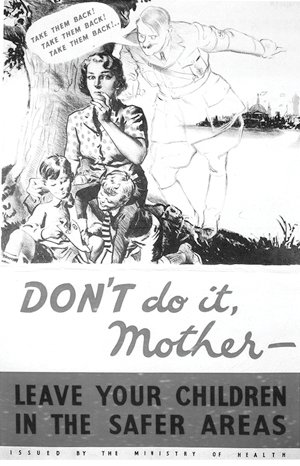
‘Don’t Do It Mother’ is the message as Hitler whispers to a mother to bring her evacuated children back from a safe area – one of a number of evacuation posters produced before and during the Second World War. (Author’s Collection)

‘Don’t Do It Mother’ is the message as Hitler whispers to a mother to bring her evacuated children back from a safe area – one of a number of evacuation posters produced before and during the Second World War. (Author’s Collection)

One of a series of evacuation posters produced by the artist Dudley S. Cowes. An illustrator of children’s books, Cowes also worked for the Ministry of Information during the war. (Historic Military Press)

A Ministry of Health poster supporting the work to find billets for evacuees. (Historic Military Press)
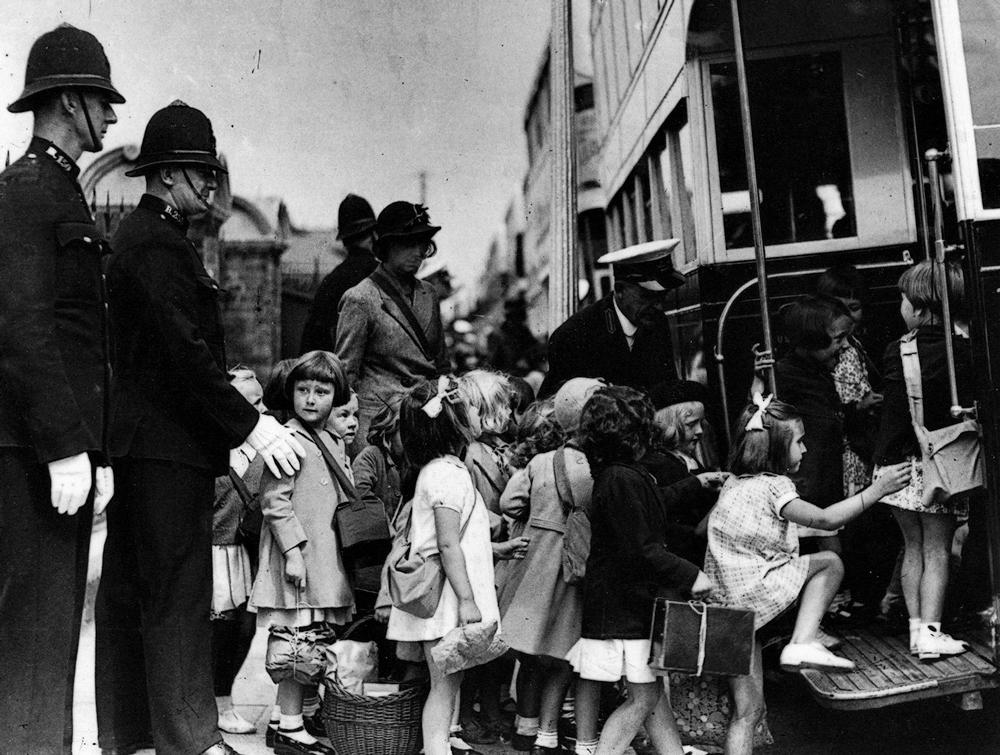
Waiting for the actual time to arrive, Portsmouth evacuees conduct an evacuation drill. (George Osborn and Home Front Museum, Llandudno)

As their journey into the unknown begins, two young evacuees, complete with their gas masks in boxes, speak to the crew of the train taking them away from their home town or city. (Historic Military Press)

The evacuation of school children from Gateshead gets underway in 1939. (Courtesy of Gateshead Libraries)

Porters at a London railway station present bars of chocolate to children being evacuated from the capital to the West Country during 1941. (Historic Military Press)

An evacuee finds comfort with teddy bear in an open suitcase. (Courtesy of the Kent Messenger Group)

These twins just filled the chair, and also themselves, as they partake of a snack before their departure for a safety area from a London railway station, February 1941. (Historic Military Press)

Grimsby evacuees relax with their teachers in the Tower Gardens in Skegness. (Courtesy of Peter Hopper)

Westcliff High School evacuees arrive at Chapel en le Frith, Derbyshire. (Courtesy of Whaley Bridge Library)

A large group of evacuees, all with their tags hanging around their neck, wait with a female Police Officer for the train that will take them away from London. (Historic Military Press)
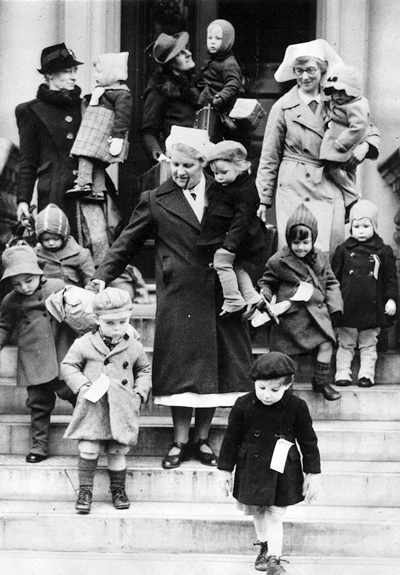
These evacuated children are pictured leaving a clearing house depot of the Women’s Voluntary Service on the first part of their journey to safety away from London’s bombs. The Matron, accompanied by a nurse and two WVS workers, is escorting the youngsters to the bus that will take them to a safety area. (Historic Military Press)

The moment of departure: a boat full of evacuees departs from the Channel Islands bound for Weymouth. The passenger ship in question, pictured here in St Helier Harbour, Jersey (note Fort Regent on the headland in the background) on 21 June 1940, is the SS Brittany. (Courtesy of Damien Horn; Channel Islands Military Museum)

A group of evacuees from one of Guernsey’s schools pictured together at a railway station in the UK. Hazel Knowles, recalled: “For the first time I saw a train. It was quite a frightening sight to see this huge monster with clouds of steam hissing from it. We then set out on a journey which seemed to take forever.” (Courtesy of CIOS Guernsey)

Horsforth prepares to receive Guernsey evacuees at Southlands. (Courtesy of Horsforth Village Museum)

‘Auntie Rose’ was a wonderful foster mother to Jack and Terry Frisby during the war. (Courtesy of Terence Frisby)

When Micky Archer arrived in Bideford, the family he had originally been allocated to would not take him in. (Courtesy of Val Morrish)
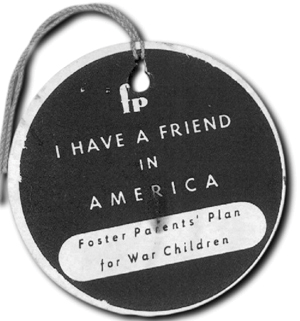
This label was attached to parcels sent to children through the Foster Parents’ Plan. (Muggeridge Family Papers)

The original caption, dated 31 December 1940, states that this image depicts British evacuee Joan Bradley, aged 7 years old, recording a Christmas message in the USA for her parents in London. Joan was the daughter of a British employee of the Warner Brothers film production company. Her group sailed to the US from Southampton. (Historic Military Press)

Hazel and Mavis Duquemin were separated during the Guernsey evacuation. (Courtesy of Hazel Duquemin)

Channel Island evacuees enjoy a Christmas meal in Cheadle Hulme, Cheshire. (Author’s Collection)

The first meeting of Channel Island evacuees in Stockport’s Reform Club. (Author’s Collection)

Alderney Headmaster, Philip Godfray, with some of the Channel Island pupils he brought to the UK mainland. (Courtesy of Anne Mauger)

Drawings included in a letter sent by Dorothy King to her parents. (Courtesy of Dorothy Miller, nee King, and Imperial War Museum)

Evacuated from the Blackfriars area of South London, these children are getting their schooling as usual. ‘As a matter of fact,’ notes the original caption, ‘they are getting their nature study first hand, with their teacher from Blackfriars pointing out noteworthy items during a walk through the Dorsetshire countryside’. (Historic Military Press)

Sadly, not every evacuee returned home. Richard Tipping, a 15-year-old evacuee from Liverpool, died on Anglesey in July 1944. This is his grave in St Mary’s Churchyard, Llanfairpwllgwyngyll. (Courtesy of Eric Jones; www.geograph.org.uk)

Faith and Stella Shoesmith who suffered at the hands of Mrs Woods. (Courtesy of Faith Catchpole)
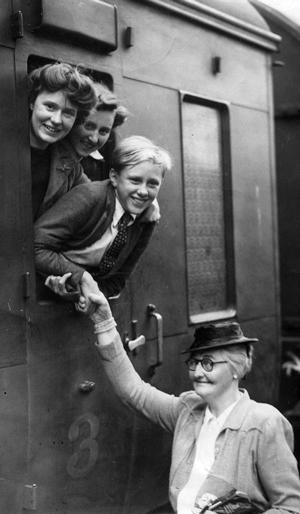
The evacuees return home. Here John Helyer is pictured leaving Bury, Lancashire, by train in 1945. He had an unhappy homecoming. (Courtesy of John Helyer)

The letter sent on behalf of John Churcher to his American foster parents at the end of the war. (Courtesy of David Churcher)

One of the many homes, buildings and camps that were used to house evacuees and which can still be seen today. These structures are the remains of Dunaird Camp (Camp No.8) at Broughshane in Northern Ireland. As the sign states, it was built to house Gibraltarian evacuees during the war. (Courtesy of Robert Ashby; www.geograph.org.uk)

Evacuees thank those who cared for them in Britain at Liberation Day parade in Guernsey, May 1946. (Carel Toms Collection, Guernsey)

One of many memorials located around the UK, the plaque on this stone in Pentre Road, in St Clears, a small town on the River Tâf in Carmarthenshire, recalls the arrival of 168 child evacuees and twenty-four adults, on 23 June 1940. (Courtesy of Chris Whitehouse; www.geograph.org.uk)

Blue Plaque at Stockport railway station marks arrival of Channel Islanders in 1940. (Author’s Collection)
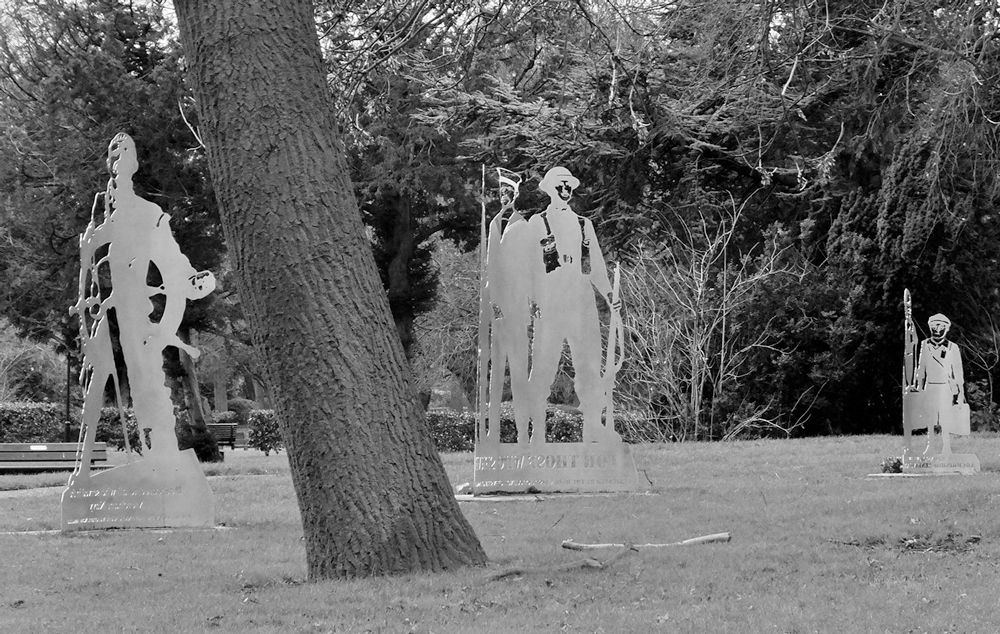
On 10 May 2015, three new memorials were unveiled in East Park in Kingston upon Hull to mark the 70th anniversary of the Second World War. The memorials comprised stainless steel cut-outs of a Merchant Navy sailor, a soldier, airman and sailor, and, on the right, evacuees. (Courtesy of Chris Whitehouse; www.geograph.org.uk)